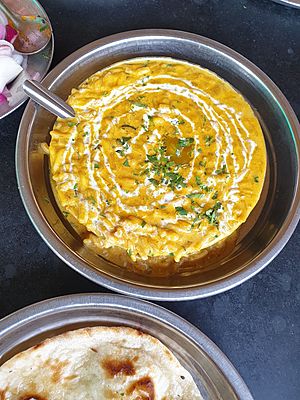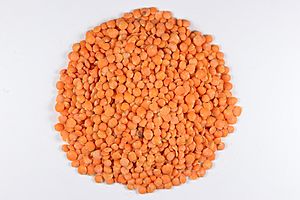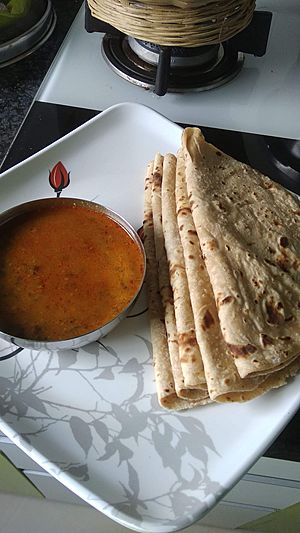Dal facts for kids
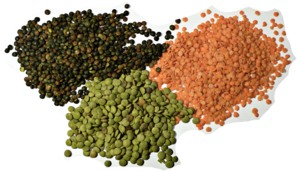
Lentils are a staple ingredient in cuisines from the Indian subcontinent. Clockwise from upper right: split red lentils, common green whole lentils, and Le Puy lentils. Whole lentils have their outer coats visible.
|
|
| Alternative names | Daal, dail, dahl, pappu, ooti |
|---|---|
| Region or state | Indian subcontinent |
| Main ingredients | Lentils, peas or beans |
Dal (also spelled daal or dhal) is a super important food in countries like India. It's made from dried, split pulses like lentils, peas, and beans. These pulses are special because you don't need to soak them before cooking!
India grows the most pulses in the world. The word "dal" also refers to the yummy soups made from these pulses. Dal is a main food for many people in South Asian countries.
Contents
What is Dal Used For?
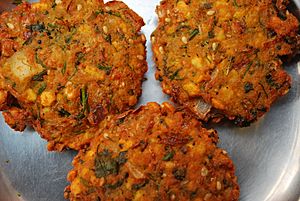
The most common way to enjoy dal is as a warm soup. People often add onions, tomatoes, and different spices to make it taste amazing.
Dal comes in a few forms:
- Whole (sabut): This means the pulse is whole, with its outer skin still on. For example, sabut urad dal.
- Split with skin (chilka): The pulse is split into two halves, but its outer skin is still attached. Like chilka urad dal.
- Split and peeled (dhuli): The pulse is split and its outer skin has been removed. This makes it cook faster. An example is urad dhuli.
People often eat dal with flatbreads like rotis or chapatis, or with rice. When eaten with rice, it's called dal bhat in some languages. Some types of dal are even fried and salted to make a crunchy snack! You can also make savory snacks by grinding soaked dals into a paste and frying them, sometimes with cashews and other spices.
Where Does the Word "Dal" Come From?
The word dāl comes from an old language called Sanskrit. It means "to split," which makes sense because dal is often made from split pulses!
Dal Around the World
Dal dishes are popular across the Indian subcontinent, eaten with rice, chapati, and naan. How it's cooked changes from one region to another. In South India, dal is often called "paruppu." It's a key ingredient in dishes like sambar and pappu (which is mixed with charu and rice).
How Healthy is Dal?
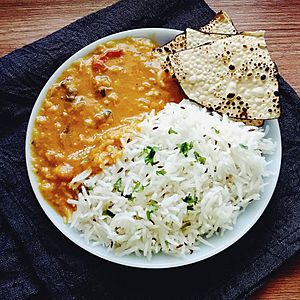
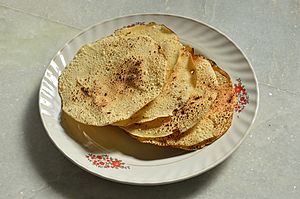
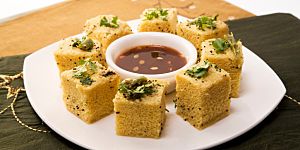

Dal is super healthy! When cooked, it has lots of protein, which helps your body grow strong. It's also full of fiber, which is good for your digestion. Dal gives you important B vitamins like folate and minerals like manganese, iron, and phosphorus. These nutrients help your body work well and keep you energized.
| Item | Water | Protein |
|---|---|---|
| Cooked rice | 68.4 | 2.7 |
| Cooked dal | 68.5 | 6.8 |
| Roti | 33.5 | 11.5 |
| Cooked soybean | 62.5 | 16.6 |
| Boiled egg | 74.6 | 12.6 |
| Cooked chicken | 64.3 | 25.3 |
Different Kinds of Dal
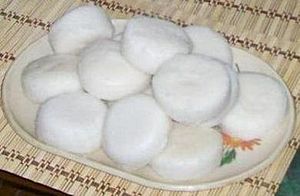
- Pigeon pea (Toor Dal): This yellow dal is very popular. In South India, it's called thuvaram paruppu or togari bele and is used in famous dishes like sambar and bisi bele bath. In North India, it's known as arhar dal.
- Chickpea (Chana Dal): This dal is made by removing the outer layer of black chickpeas and splitting them. You can even do this at home!
- Yellow Split Peas (Matar Dal): Very popular in countries like Guyana and Fiji, and also in India. It's the main ingredient in the Bengali street food ghugni.
- Mung Bean (Mung Dal): This is a favorite in Bangladesh and West Bengal. It's used in the Tamil dish ven pongal. Roasted mung beans are also a popular snack.
- Black Gram (Urad Dal): Sometimes called "black gram," this dal is key for South Indian dishes like idli and dosa. It's also used to make sun-dried dumplings called bori. It's packed with protein!
- Red Lentils (Masoor Dal): These are split red lentils.
- Kidney Beans (Rajma Dal): These are split kidney beans.
- Panchratna Dal: This means "five jewels" and is a mix of five different dals, creating a unique flavor.
- Moth Bean: This dal is used in popular Indian snacks like bikaneri bhujia and Maharashtrian dishes misal and usal.
Some pulses are split but still have their skin on; these are called chilka dals.
Whole vs. Split Pulses
While "dal" usually means split pulses, whole pulses are called sabut dhal. When pulses are peeled (hulled), it can make them easier to digest and taste better. However, removing the skin can reduce some of the fiber. Both whole and split pulses are very popular in the Indian subcontinent, with over 50 different kinds!
How to Cook Dal
Most dal recipes are quite easy! First, you boil the dal (or a mix of dals) in water with some turmeric and salt.
The special part comes at the end: adding a fried garnish! This garnish has many names like chaunk, tadka, or bagar. To make it, you fry spices like cumin seeds, mustard seeds, and dried red chili pepper in hot oil. Then, you might add ginger, garlic, and onion and fry them until golden. Finally, ground spices like coriander and red chili powder are added. This flavorful chaunk is then poured over the cooked dal, making it super tasty!
| Food | Carbs (non-Fiber) | Fiber | Protein | Fat |
|---|---|---|---|---|
| Wheat | 100 | 20.6 | 21.3 | 2.5 |
| Rice | 100 | 1.6 | 9 | 0.8 |
| Soybean | 100 | 44.2 | 174 | 95 |
| Pigeon Pea | 100 | 31 | 45.4 | 3 |
| Milk | 100 | 0 | 61 | 61.8 |
| Guava | 100 | 60 | 28.6 | 11.2 |
| Carrot | 100 | 41.1 | 14.7 | 3.6 |
| Spinach | 100 | 157 | 207 | 28 |
| Potato | 100 | 14.4 | 13 | 0.6 |
| Sweet Potato | 100 | 17.7 | 9.4 | 0.5 |
| Eggplant | 100 | 148 | 43.4 | 8.6 |
| Apple | 100 | 21 | 2.2 | 1.4 |
| Orange | 100 | 25.6 | 1.0 | 1.2 |
Note: Carbohydrates do not include fiber. Source:https://fdc.nal.usda.gov
See also
 In Spanish: Dal (alimento) para niños
In Spanish: Dal (alimento) para niños


